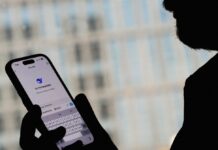Trump has claimed prices are coming down “50, 60 even 70 percent.” He has said Medicare premiums are coming down. And he has suggested pushback from the pharmaceutical industry proves his efforts have been successful.
Here’s a quick guide to cut through Trump’s rhetoric about what he’s done to lower the cost of pharmaceutical products.
Claim No. 1: “I am lowering drug prices massively.”
For a short period of time, prices did somewhat drop. Consumer prices for prescription drugs fell 0.6 percent in 2018, according to the Bureau of Labor Statistics.
But the trend reversed last year, when prices increased 3 percent — the sixth-highest category of growth after smoking products, medical care, energy, shelter and food away from home.
This past July, a month in which drug manufacturers traditionally hike prices, 67 drugs increased in cost by an average of 3.1 percent, according to GoodRx, an online prescription cost service. More than 850 brand-name and generic drugs increased in price by an average of 6.8 percent in the first six months of the year.
In a new analysis released yesterday, GoodRx found drug prices are surging faster than any other medical service or good, increasing by 33 percent since 2014.
Claim No. 2: “We will be substantially LOWERING Medicare Premiums.”
Assuming Trump was referring to Medicare’s prescription drug program (Part D), he’s correct that monthly premiums are going down.
Seniors will pay an average of $30.50 for a basic Medicare Part D premium in 2021, the Centers for Medicare and Medicaid Services announced in late July. That’s down 7 percent from 2018 and down 12 percent from 2017, following a half-decade of Part D premiums remaining flat or increasing only modestly.
The news got little attention when CMS Administrator Seema Verma announced it in July, crediting the decrease to administration policies encouraging “choice and competition.” She also noted that seniors will be able to choose a plan capping co-pays for insulin at $35 a month — a new policy Trump had announced in May.
“At every turn, the Trump administration has prioritized policies that introduce choice and competition in Part D,” Verma said in a statement.
Claim No. 3: “My Most Favored Nation order will ensure that our country gets the same low price Big Pharma gives to other countries.”
Trump signed an executive order — and updated it on Sunday — telling the government to experiment with how Medicare pays drug companies.
The approach certainly could help lower U.S. drug prices, if it ever gets to home plate. However, it’s not even to first base.
As we explained in Monday’s Health 202, Trump’s executive order says the Department of Health and Human Services will implement what is known as “the most favored nation policy.” The idea is to require drugmakers to accept the lowest government price for medicines paid by comparably wealthy countries in Europe and elsewhere, as a way of tamping down drug prices overall in the United States.
Yet Trump has been promising several iterations of this idea for nearly two years, and HHS has never actually proposed rules for how such a policy would work. Even if the agency were to move forward on the proposal as an experiment, it would apply only to a limited number of payments and would face an expiration date.
Claim No. 4: “REBATES ARE BRINGING PRICES DOWN NOW.”
Trump was referring to the widespread practice in which drugmakers give rebates to pharmacy benefit managers, which are essentially insurance middlemen. These savings are generally not passed along to consumers — and they encourage drugmakers to raise the list price of drugs year after year, so that the rebates can grow.
Trump had previously tried to ban these rebates, just as he had previously proposed the favored nation policy. But his administration killed a rule on such a ban last year, after seeing projections that it would raise Medicare premiums for many seniors. Trump returned to the idea in July, signing an executive order to ban the rebates (one of four drug pricing executive orders he signed).
But the move has no immediate effect, as moving forward would require further action by HHS. The proposal faces immense opposition by the insurance industry, and policy experts don’t expect it to go anywhere anytime soon.
Ahh, oof and ouch
AHH: Moderna and Pfizer released details of their vaccine trials.
Public health experts had been calling for greater transparency about the vaccine trials to shore up public trust in the process.
“Leaders of Moderna and Pfizer cited the need for greater transparency than usual in covid-19 clinical trials as the reason behind their decision to release the full documents describing how their studies will measure safety and effectiveness,”The Post’s Carolyn Y. Johnson reports.
To determine if a vaccine is effective, companies must wait until the virus spreads naturally within the study population. Then they can, analyze whether cases of covid-19 are mostly appearing in people who received the placebo, or if people who received the vaccine are also getting sick.
Moderna’s planning document anticipates that the first analysis will take place in December, although the company’s executive Stéphane Bancel said he now expects it will be ready in November. In recent weeks, Pfizer has said that it expects to have sufficient data by the end of October.
Some experts think October is unrealistic.
“Mid-October — that all defies the math of the enrollment, the follow-up, the second booster shots. It doesn’t even compute, if it’s done right,” Eric Topol, a cardiologist at Scripps Research Translational Institute, told The Post.
Trump has maintained a vaccine will be broadly available this fall, perhaps as early as October, contradicting a longer timelime laid out by CDC Director Robert Redfield.
On Wednesday, Democratic presidential nominee Joe Biden raised the specter of Trump pressuring agency officials to prematurely approve a vaccine.
“I trust vaccines. I trust scientists. But I don’t trust Donald Trump,” Biden said at a speech in Wilmington, Del.
Trump hit back yesterday, tweeting that Democrats were “angry” that vaccines were ahead of schedule.
OOF: A former Pence aide plans to vote for Biden because she believes Trump’s coronavirus response showed a disregard for human life.
Olivia Troye, who worked as a homeland security, counterterrorism and coronavirus adviser to Vice President Pence for two years before leaving the White House in August, said that President Trump’s response to the coronavirus showed a “flat-out disregard for human life,” Josh Dawsey reports.
“The president’s rhetoric and his own attacks against people in his administration trying to do the work, as well as the promulgation of false narratives and incorrect information of the virus have made this ongoing response a failure,” Troye told The Post.
Troye, who describes herself as a lifelong Republican, said she attended and helped organize “every single meeting” the White House coronavirus task force held between February and July. She claimed the task force was often blindsided by statements made by the president and that Trump’s refusal to embrace masks cost the administration months in slowing the virus’s spread.
“Troye is the first Trump administration official who worked extensively on the coronavirus response to forcefully speak out against Trump and his handling of the pandemic,” Dawsey writes. “She joins a growing number of former officials, including former national security adviser John Bolton and former defense secretary Jim Mattis, who have detailed their worries about what happened during their time in the administration while declaring that Trump is unfit to be president.”
The White House characterized Troye as a disgruntled former employee. Retired Lt. Gen. Keith Kellogg, Pence’s national security adviser, said Troye reported to him and never expressed concern about the coronavirus response to anyone in her chain of command.
Troye appeared in an ad posted by Republican Voters Against Trump:
OUCH: Controversial testing guidelines bypassed the CDC’s scientific review.
“A heavily criticized recommendation from the Centers for Disease Control and Prevention last month about who should be tested for the coronavirus was not written by C.D.C. scientists and was posted to the agency’s website despite their serious objections, according to several people familiar with the matter as well as internal documents obtained by The New York Times,” The Times’s Apoorva Mandavilli writes.
The guidance quietly posted on the CDC website on Aug. 24 said that people who had been in close contact with someone who tested positive for the virus did not “necessarily need a test.” It caused consternation among many public health officials who have been calling for widespread testing to help contain asymptomatic transmission of the virus.
The New York Times quotes several anonymous CDC officials who said that guidelines, while originally from the CDC, were rewritten by HHS and bypassed the CDC’s scientific review process. Some sources said the guidelines contained style differences and glaring errors — such as a reference to testing for covid-19 rather than the virus that causes it — that were a giveaway it had not been edited internally.
Officials also told the Times a new version of the testing guidance, expected to come out this week, also bypassed the internal review process.
Adm. Brett Giroir, the administration’s testing coordinator and an assistant secretary at HHS, said the guidelines were drafted by the CDC and that the editing process involved input from Redfield.
New documents reveal how the U.S. Postal Service grappled with the pandemic.
A cache of thousands of internal documents from the Postal Service reveals an agency struggling in the early months of the pandemic to manage a budget crisis and a standoff with Amazon, which threatened to take part of its business elsewhere, even while panicked postal workers raised concerns that their jobs could expose them to the coronavirus, Tony Romm, Jacob Bogage and Lena H. Sun report.
The Post obtained nearly 10,000 pages of emails, legal memos and other documents, mostly from March and April, from American Oversight, a watchdog group that requested them under the Freedom of Information Act.
The documents also reveal that USPS was further along in a plan to ship masks to every American household than previously reported.
“At one point in April, USPS leaders drafted a news release announcing plans to distribute 650 million masks nationwide, enough to offer five face coverings to every American household. The document, which includes quotations from top USPS officials and other specifics, was never sent,” Tony, Jacob and Lena write.
The plan was ultimately nixed in favor of a HHS plan called Project America Strong, a $675 million effort to ship masks to companies, health-care facilities, schools, and faith-based and community organizations. An HHS spokesperson told The Post that about 600 million of the 650 million masks had been distributed.
A report finds more government action is needed to protect nursing homes from the coronavirus.
“The Trump administration is claiming ‘resounding vindication’ from an independent commission’s report on the coronavirus crisis in nursing homes, but some panel members say that’s a misinterpretation of their conclusion that much remains to be done to safeguard vulnerable residents,” the Associated Press’s Ricardo Alonso-Zaldivar reports.
The commission, was set up by CMS, put forward 27 recommendations to protect nursing home employees and residents. While long-term care residents make up only 1 percent of the population, they account for 40 percent of coronavirus deaths.
The administration said that it has already made progress on most of issues in the report, and Verma called its findings “an invaluable action plan for the future and a resounding vindication of our overall approach to date.”
But some panel members expressed that much remains to be done and said the report was intended to guide future actions, not evaluate the administration’s response.
“There’s a sense of ‘mission accomplished’ ” within the administration, and “that’s just not the case,” Harvard professor David Grabowski, a member of the commission, told the AP.
Among other recommendations, the report calls for establishing a national testing strategy, guaranteeing sufficient personal protective equipment, and safely resuming family visits.
Coronavirus latest
- HHS Secretary Alex Azar will appear in front of the House Oversight and Reform select subcommittee on the coronavirus crisis on Oct. 2 to testify about the Trump administration’s response to the pandemic, the Hill’s Tal Axelrod reports.
- U.S. manufacturers are aiming to produce 100 million antigen tests per month by the end of the year. The sharp increase in antigen tests, which are considered faster but less accurate than lab-based tests, could open up the possibility for regular screenings at schools and workplaces, Reuters’s Carl O’Donnell reports.
- Trump administration pandemic adviser Scott Atlas railed against YouTube after it removed a video of an Hoover Institution interview in which Atlas expressed skepticism about social distancing restrictions. A YouTube spokesperson said the company removed the video because it violated policies meant to combat misinformation about the coronavirus “by falsely stating that a certain age group cannot transmit the virus.” Atlas compared the video’s removal to censorship in “Third World countries,” Lateshia Beachum and Kim Bellware report.
- A report from international aid organization Oxfam finds that rich nations, representing only 13 percent of the world’s population, have already struck deals for more than half of the future vaccine supplies anticipated from leading pharmaceutical companies. The aid agency warned that companies do not have enough vaccines for everyone who needs them.
- World Health Organization emergencies chief Mike Ryan called for “consistent messaging” from top public officials during a news conference on Thursday. The remark came in response to a question about Trump and Redfield, the head of the CDC, contradicting each other over a vaccine timeline, The Post reports in its Live Updates on the virus.
The ongoing debate over reopening schools
- As schools reopen across the country, researchers are hoping to learn more about coronavirus transmission among children. “But efforts to screen kids may be hindered by several factors: age limits at certain testing sites; fear of or discomfort from swab testing; and the tendency for children to not exhibit signs of infection, making them less likely to qualify for immediate testing,” Meryl Kornfield reports.
- An AP analysis of the 50 counties with the highest concentration of college students found 20 of those counties have consistently reported higher rates of new virus cases compared to the overall rates in their states. In those 20 counties, rates were three times as high on average as the overall rate in the state, the AP’s Casey Smith, Irena Hwang and Collin Binkley report.
- New York City public schools had been scheduled to open on Monday, but Mayor Bill de Blasio (D) again delayed the start of in-person classes in most of the city’s public schools, the Times’s Eliza Shapiro reports.
Smoke alarm
Wildfires are causing health problems on the West Coast.
“The haze along the West Coast has created the most polluted air in the world over the past week, forcing millions of residents indoors,” The Post’s Heather Kelly and Samantha Schmidt report. “Going outdoors is dangerous for even healthy lungs, and exercising has largely been out of the question.”
Some businesses have closed because the poor air quality makes it too risky for their employees to come to work.
But health experts say that even people who take all of the precautions may still face risks, as small smoke particles from wildfire find their way deep into people’s lungs and bloodstream. While the risk is highest for those who have asthma or lung disease, at the current levels of smoke, even healthy people are likely to start feeling symptoms. Long-term exposure can increase the risk of heart disease or stroke.
Coronavirus-related restrictions on indoor activities have also made the situation harder, and N95 masks, which offer the best protection against the smoke, are in short supply because they are needed by health-care workers.
Smoke may clear over the next week, but with wildfire season only halfway over, any “fresh air might be temporary,” Heather and Samantha write.








